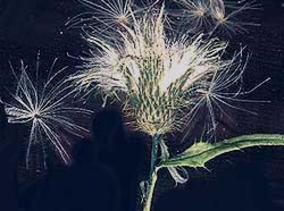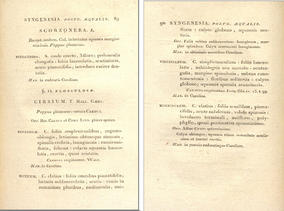You are here
Taxonomy
Cirsium
Nomenclature
-
Family: Compositae
SUMMARY
"Thistle, chardon [Greek kirsion, thistle]
Annuals, biennials, or perennials, 5–400 cm, spiny. Stems (1–several) erect, branched or simple, sometimes narrowly spiny-winged. Leaves basal and cauline; finely bristly-dentate to coarsely dentate or 1–3 times pinnately lobed, teeth and lobes bristly-tipped, faces green and glabrous or densely gray-canescent, usually eglandular. Heads discoid, borne singly, terminal and in distal axils, or in racemiform, spiciform, subcapitate, paniculiform, or corymbiform arrays. ( Peduncles with ± reduced leaflike bracts.) Involucres cylindric to ovoid or spheric, (1–6 ×)1–8 cm. Phyllaries many in 5–20 series, subequal or weakly to strongly, outer and middle with bases appressed and apices spreading to erect, usually spine-tipped, innermost usually with erect, flat, often twisted, entire or dentate, usually spineless apices (distal portion of phyllary midveins in many species with elongate, glutinous resin gland, usually milky in fresh material but dark brown to black when dry). Receptacles flat to convex, epaleate, covered with tawny to white bristles or setiform scales. Florets 25–200+; corollas white to pink, red, yellow or purple, ± bilateral, tubes long, slender, distally bent, throats short, abruptly expanded. cylindric, lobes linear; (filaments distinct) anther bases sharply short-tailed, apical appendages linear-oblong; style tips elongate (as measured in descriptions including the slightly swollen nodes, long cylindric fused portions of style branches and very short distinct portions). Cypselae ovoid, ± compressed, with apical rims, smooth, not ribbed, glabrous, basal attachment scars slightly angled; pappi persistent or falling in rings, in 3–5 series of many flattened, plumose bristles or plumose, setiform scales (longer bristles shorter than corollas except in C. foliosum and C. arvense). x = 17.
Species ca. 200 (62 in the flora): North America, Eurasia, n Africa.
Only three genera in Cynareae are represented by native species in the New World, and of these Cirsium is by far the most widely distributed and diverse. Native species of Cirsium range from sea level to alpine and from boreal regions of Canada to the tropics of Central America. Members of the genus occur in a myriad of habitats including swamps, meadows, forests, prairies, sand dunes, and deserts.
Preliminary molecular phylogenetic studies by D. G. Kelch and B. G. Baldwin (2003) indicated that this diversity is the product of a rapid evolutionary diversification based upon a single initial introduction from Eurasia. Relationships among the North American species are apparently complex, and molecular studies have only begun to provide an outline of phylogeny for these plants. Although there has been a remarkable evolutionary and morphologic diversification in North American Cirsium, it has not been accompanied by very much divergence in the base sequences of genes commonly used to elucidate phylogenetic relationships. This suggests either that the diversification has been very rapid or that genetic markers in North American Cirsium mutate more slowly than in most other lineages.
Chromosomal diversification has accompanied the morphologic radiation of North American Cirsium. Many New World Cirsium species share the chromosomal base number of x = 17 that also predominates in most Eurasian species. Among the North American thistles, however, is a mostly descending dysploid series with chromosome numbers ranging from n = 18 to n = 10. Very few instances of polyploidy are known among New World Cirsium.
Cirsium species of remarkably different morphologies often are able to hybridize. Although in some hybrid combinations fertility is reduced, in others the formation of complex hybrid swarms indicates a lack of breeding barriers and the potential for emergence of novel character combinations. In the absence of adequate sampling and field observations, hybrids may go unrecognized—treated as distinct taxa or as variants of non-hybrid taxa, or left occupying the indeterminate folders of herbaria. In other cases hybridization has been invoked without much evidence as an explanation for Cirsium variants encountered in herbaria or in the field. Hybrid combinations are listed herein when evidence is convincing. Additional hybrids are likely to be found where the ranges of Cirsium species overlap. I have seen no documentation of hybridization between native American Cirsium species and introduced Eurasian taxa.
Much of the geographic range currently occupied by New World Cirsium species was greatly affected by the events of the Quaternary. Large areas were glaciated and other areas were vastly different during glacial episodes. The ancestors of thistles that currently occupy the high mountains of western North America were undoubtedly displaced elevationally and/or latitudinally during the recurrent glacial and interglacial episodes of the Pleistocene. Taxa that are currently isolated may have been in contact during glacial episodes with the opportunity for hybridization and genetic interchange. Episodes of prehistoric hybridization may have led to some of the character combinations found in modern American thistles, particularly in the western half of the continent. Current isolation and localized selection or genetic drift apparently have promoted differentiation of populations separated on mountaintop islands.
One of the most challenging aspects for a taxonomist studying New World Cirsium is the presence of species complexes that are apparently evolutionary works in progress. Some of the thistles, especially in the mountainous western part of North America, are frustratingly polymorphic with much overlapping variability and intergradation of characters. Early taxonomists, basing their work on a limited sampling of the morphologic diversity, named many of the forms as species, and the literature is rife with species names. The infilling that results from more collectors visiting more localities within the ranges of these complexes has blurred the boundaries between many of the proposed species and often added forms that do not "fit" the characteristics of named species. As I faced the challenges of preparing this treatment, I recognized that maintaining some of the named entities as species would, for consistency, require a further proliferation of species names. I have chosen to go the other way. Instead of proposing yet more ill-defined microspecies, I have chosen to recognize that the groups in question are rapidly evolving, only partially differentiated assemblages of races that have not reached the level of stability that is usually associated with the concept of species. Certainly much of such variation within the genus deserves a level of taxonomic recognition, or at least should be mentioned, but for those assemblages I think it much more prudent to recognize varieties—entities that may be expected to freely intergrade—rather than species.
Many problems remain to be worked out in North American Cirsium. Further investigation will undoubtedly reveal the need for refinement or major revision within some of the species groups. Studies that focus on variation within and among populations and on the biological basis for the variations are much needed. The field is open and the challenges are many.
Preparation of a workable key to Cirsium species has been frustratingly difficult. Extensive and overlapping ranges of variation in morphologic characteristics often require that a species be keyed two or more times. The resulting key is longer and more complex than I would prefer, and I have no doubt ignored, overlooked, or been completely unaware of variants that will not key out. Caveat clavitor!
The reputation of Cirsium has suffered greatly as a result of the introduction to North America of a few invasive weedy species from Eurasia. Cirsium vulgare (bull thistle) and C. arvense (Canada thistle—a misnomer) have long been despised as noxious weeds. In recent years C. palustre (European swamp thistle) has joined their ranks. Additionally, weedy Eurasian species of Carduus, Onopordum, Centaurea, etc., add to the public perception that all thistles are bad. Most North American native Cirsium are not at all weedy, and many are strikingly attractive plants. All are spiny plants that command respect, but they deserve a better reputation as one of North America’s evolutionary success stories.
Native Cirsium species have come under threat from biocontrol programs instituted to suppress populations of weedy introduced thistles. Beginning in 1968 the seedhead weevil Rhinocyllus conicus has been widely introduced in various areas of the United States and Canada, primarily to control weedy species of Carduus. S. M. Louda et al. (1997) reported that R. conicus has crossed over to several native species of Cirsium. They observed that the number of viable cypselae in infested heads was greatly reduced; e.g., heads of C. canescens infested by R. conicus produced 14.1 percent of the number of viable cypselae as in uninfested heads. Not all taxa are impacted as much as C. canescens, particularly those with later flowering phenology (Louda 1998). R. W. Pemberton (2000) reported that 22 Cirsium taxa in North America are known hosts of R. conicus. I suspect that the number is higher. During my field work I have observed that the heads of many Cirsium species are heavily parasitized, although I have not determined which of these are infested by R. conicus and which by native seedhead parasites. The long-term impacts of R. conicus and other biocontrol agents on native thistles, particularly rare taxa, remain to be determined."
Keil, David J. “Cirsium” in Flora of North America, Vol. 19, pp.95-164, Oxford University Press, Inc., New York, NY. 2006.
.






